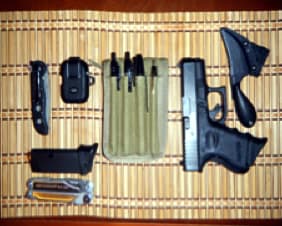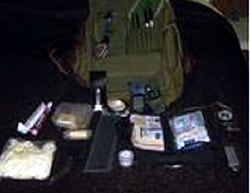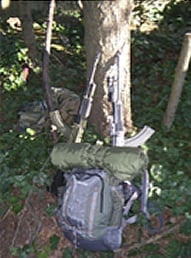Part I - Practical Survival Equipment
In this segment of the Emergency Assessment series, we’re going to discuss equipment, but not in a way that is commonly seen.
We’re going to take the information from the previous segment (Understanding Emergencies) and set up some definitions that we will use to frame what we need in order to meet emergencies head on. If you have not yet read that article, please take a few minutes to read it now, because this article builds on the knowledge gained in the previous one.
Most of the time, this discussion focuses on what you hear when you hear “survivalists” consider their options. Typically it’s the equipment: What rifle for deer? What (this) to accomplish (that)? Our section on equipment is intentionally placed halfway through this article, because before we decide on any sort of equipment, it’s imperative that we shape our demands, and our demands are not equipment -- our demands are skills. A set of lock picks aren’t going to do you any good if you’re trying to escape a dead city and you can't tell a rake from a torsion wrench.
In short, our priorities are:
- A cogent assessment of the situation
- A detailed plan on what you have, lack, and need, in terms of skill set, mindset, and know-how
- The skills to perform the given task
- The tools to perform the given task
With skill comes mindset; with mindset comes tactical thinking. Therefore, when we are skilled, we can “think on our feet.” When you understand the objective, it becomes easier to improvise. This is especially true of firearms, though it applies equally to many other things.
In the spirit of “consistency across categories,” I arrange my equipment to correspond with the levels of crisis discussed in my previous article in the “Intensity/Duration” section, which is to say, each of the three “lines” of equipment meet the demands of their respective emergencies.
Furthermore, integration of each line should be additive -- your line two should be commensurate with your first and third line. If you’re left with only your first line, you should have the mindset, skill set, and tactical knowledge to “procure” any of the other items you may need.
Consider a few other points:
- Try not to look conspicuous. Dress appropriately for what you’re doing. Carry clothes that are inconspicuous for your area, and make sure you’re comfortable (not just physically – dress in a way that you’re inconspicuous).
- Don’t overload yourself. Try and stick to the target weights, or define your own as needed.
- Make sure your equipment is secured and doesn’t rattle. Tie it down with Paracord and make sure your pouches are secure. Zippers and velcro make noise. Buttons are quieter. Keep your cell phone on vibrate, not ring.
- Buy quality; cry just once. Don’t buy equipment off the bargain rack to fill a perceived insufficiency -- use the skill axiom first! If you can’t overcome the deficiency with just skill (such as in an emergency like a house fire), buy reliable, quality tools to augment your knowledge.
- Try to find objects that are “multi-purpose,” but be aware that some things will always need to be “special purpose.”
Often enough, people ask, “What do I need?” This, of course, depends greatly on what skills you possess, your perceived dangers, and what you’ll actually carry. That said, I will do my best to make my recommendations.
First Line
 Method of Carry: EDC “Every Day Carry" on person
Method of Carry: EDC “Every Day Carry" on person
Target weight: 1-5 lbs.
Purpose: Mitigation of immediate emergencies and violent encounters; supplementing second and third line in more protracted emergencies. Our first-line equipment is designed to provide us with readily accessible, functional tools for both everyday situations (increasing the likelihood that we’ll actually carry it) and Type 1 emergencies.
The emphasis with your first line gear is:
- Rapid accessibility
- Lightweight
- Discreet (“low signature”)
- In-fight accessibility (see the Forum for logic behind this)
Please note: If you’re not comfortable carrying a firearm, that’s fine; it's a small part of the overall preparation.
Components
-
-
- Pocket knife
- Lighter/matches
- Thumb drive (on key ring)
- P-38 can opener (on key ring)
- Multi-tool (I prefer Gerber - Leatherman pictured)
- A notepad with pens
- A rubber band or two
- Safety pins
- Photon flashlight (or handheld flashlight – depending on what you prefer)
-
Optional
-
-
- Sidearm (I prefer a Glock 26/19, in 9mm)
- A reload for your sidearm
- A fixed blade knife (I prefer a Shivworks Clinch Pick)
- Bogata Entry Toolset
- A Paracord bracelet - deconstructed, these can provide you an amazing amount of material to use as rope, fishing line, snare wires, or thread - the limits are only in your mind.
-
Second Line - Kit
 Method of Carry: Lightweight satchel or low-signature chest rig
Method of Carry: Lightweight satchel or low-signature chest rig
Note: NOT a backpack - a backpack is your third line.
Target Weight: 5-10 lbs.
Purpose: Putting emergency plans into effect; geared towards Moderate Intensity, Medium Duration (Type II) emergencies. For my second-line equipment, I prefer a setup that doesn’t interfere with my first line, so that the lines can be seamlessly integrated to fit the caliber of emergency.
The second-line kit serves as augmentation to the first-line equipment, providing support for tasks such as navigation and waypoints, emergency medical supplies, and equipment to improvise food and shelter.
Components
-
-
- Water container
- Zip ties
- Siphon hose
- Spare magazines
- Head lamp
- Flashlight (I prefer the Surefire C2)
- Pocket chainsaw (this is an endorsement -- it rocks)
- Snare wire and fish hooks (tied on their leaders)
- Notepad and pens
- Magnesium fire starting block
- Medical kit
- GPS/compass
- A few pieces of silver
- More Paracord
- Cyalume flares
- Water bottle
- Idiosyncratic items (Kestrels, GPS, maps, reading material; whatever makes you comfortable)
-
Optional
-
-
- Rifle
- Spare magazines (pistol/rifle)
-
Third Line - Backpack

Method of Carry: Backpack
Target Weight: 25-40 lbs.
Purpose: Providing more advanced gear that supplements first and second line, and affords the ability to exist in transit for >1 week, depending on level of skill and need.
Components
-
-
- Food (I prefer MRE entrees with the cardboard [for fire starting])
- Sleeping bag or insulated blanket
- Mylar sleeping bag and/or space blanket
- Fixed-blade knife
- Rope/carabiners
- Hydration system (3 Litre)
- Plastic bags
- Medical kit
- Capilene underwear, shirts, and socks (2 pairs each)
- Stainless steel or aluminum cook-set (with utensil)
- Fishing line/hooks/power-bait
- Water purification (tablets, Pur Hiker/Katadyne etc)
- Canteen with cup
- Extra items: lighters, pens, trading items (cigarettes, silver, etc.)
-
Keep in mind that a heavier third line might include more food, water, a bedroll, and a better sleeping bag. This equipment should be geared towards your level of skill and individual plan to facilitate getting you where you need to be –- whether that is home after hoofing it from the office, or moving on foot to a remote location.
Part II - EDC and Emergencies: Building a Training Plan
Training For Your Emergency
Each of us has a different set of circumstances that will dictate how we prepare, what we prioritize, and what we decide to carry with us. Because the needs and comforts of each person will differ, we’ll take a very “generic” look at how I plan my training each year:
- Identify Deficiencies
- Identify Needs
- Research Options
- Attend Training
- Verify Training
- Reassess Needs
The final step is probably the most critical – many people attend one course, find that they’re ‘proud’ of their new-found skill, and then put it in a box, on a shelf, and forget about it until it turns to dust. If you’re not constantly looking to improve, the shelf-life of your skill level will expire. With that, let’s explore some of the core competencies, training opportunities, and the accompanying equipment in this next section.
Defining Skill Set
Since we’re all starting (or reassessing and restarting) from different positions, there are no “one-answer” solutions.
That said, there are two common themes in Type I emergencies -- First Aid and Self Defense -- and these two form the bedrock on which all Type I emergencies are based on. There are a number of venues where you can gain these skills, from martial arts to CPR. It’s up to you to determine the best route. What we will do in this section is define skills that will help you plan the subsequent action to remedy the identified deficiencies. These will simply be the “core tasks” that I see as necessary – there are infinitely more, but to give us a ‘broad’ look at a variety of skills, the following lists will provide a Foundation, Frame, and Firebreak for our skill-set homestead.
Type I Emergency Skill Set:
Physical Fitness – From exiting a burning building, swimming to shore, or running from an attacker, your level of physical fitness is the foundation all other skills are built upon. See Chris’s terrific writeup for inspiration and a great, actionable plan: Getting In Shape: The New Me
First Aid – Knowing the ABC’s of rescue medicine, CPR, how to splint and carry, and knowing the difference between types of bleeding is the bare essential. Most hospitals have CPR classes that are free or nearly so. Many colleges, including community colleges, have First Aid classes that are affordable and brief, and you will also likely receive your CPR card.
Self Defense – Self defense, like medicine, is a subject you can quit, but never finish. It’s up to each individual to decide what they’re comfortable with in terms of the ability to defend themselves. At a minimum, take a class or two on mental awareness and some basic preventative techniques or martial arts. Situational awareness goes a long way towards diffusing problems before they start, but make sure you also take some basic precautions, starting with the internal fortress and moving your way outwards towards securing your home (Fortifying Yourself And Your Home Against Crime) and community.
If you choose to own a firearm, be sure to take a course on handling and safety, and a class in Force on Force. Learning to shoot without measuring your skill against another adversary is not going to allow you to successfully cycle through steps 5 and 6 in the training cycle. Wouldn’t it be silly to take martial arts without ever sparring with an opponent?
Type II Emergency Skill Set:
Rural Survival Basics: As a minimum, you should know how to purify water, start a fire and build a shelter. Knowing your local area’s flora and fauna will be very helpful as well – edible berries, mushrooms and bulbs can and will help alleviate hunger if you’re forced to live outdoors for any measure of time. Make no mistake, this is far and away the most difficult and risky proposition for a post collapse world, and should not be under-estimated. While there are many schools which teach these skills, (Tom Brown’s Survival School, Davenport’s Survival School etc) the best way to learn is to learn from someone you know who is a skilled outdoors man.
Urban Survival Basics: In the Urban environment, you might find yourself in a situation where traveling discreetly, scavenging for goods and interacting with people are your primary concerns. While there are various ways to learn these skills, many have to come through experience. OnPoint Tactical’s “Urban Escape and Evasion” is an excellent option (http://www.onpointtactical.com/scout.aspx), and in my opinion an extremely valuable addition to your skillset. That said, it’s very challenging and some of the curriculum might give some folks pause.
Advanced First Aid: From my perspective, this encompasses suturing, wound management, treat bleeding, wound packing, Tourniquet use, decompression of tension pneumothorax and IV use. These skills are geared towards working under extremely tough circumstances, such as a terrorist attack, active shooter incident or even a car accident. Tactical Response Immediate Action Medical is essentially the same as the U.S. Army’s Combat Lifesaver Course, but geared more towards the citizen, and will definitely give you good hands on skills to deal with trauma (http://www.tacticalresponse.com/course.php?courseID=36), but there are many other courses available that will adequately equip you to address these concerns.
Advanced Self-Defense: Advanced self defense takes us out of the realms of just not getting beaten up, and advances us to the ability to actively defend the family if need be. This includes the ability to manage street fights using unarmed, edged, and firearms skill sets we develop in Type 1 defense. This is a very uncomfortable stage of development, where we begin testing ourselves in force-on-force and taking more difficult challenges such as navigating buildings or active shooter situations. Classes in Brazilian Jujitsu and Shivworks ECQC/AMIS/VCAST sequence will go long way in building your ability to fight on the street or in buildings, and manage contacts while in your vehicle. (http://shivworks.com/)
Type III Emergency Skill Set:
Agriculture: food production, animal husbandry, canning, curing, gardening and permaculture.
Energy Production: solar & hybrid generators, wood gasification, biofuels
Costs and Practicality
This list may seem long and costly, and it is.
The skill sets presented in this series are meant to be the foundation that, if practiced properly, will ensure that your basic needs are met. It is incumbent upon you to develop those skills.
Turning these words into practical, useful skills will require an investment in time, energy, and patience. It will cost money, pride, and comfort. But as you invest in yourself and build confidence in the things you can accomplish, you’ll see the investment return all of what it’s taken.
The journey of self-development is very long, lonely, and at times will have you questioning your motives, intent, and possible outcomes. It should be harsh, painful, rewarding, and humbling.
The training you complete is an investment in your most integral asset: yourself. Budget for it as you would any other expense, and continually view it as a way to weather yourself against the unexpected challenges.
Some of the simplest things you can do are:
- Take martial arts.
- Take good care of yourself physically.
- Find two courses per year that you’ve never taken before; budget for and attend them.
- Consider equipment only after you’ve identified need. Continually re-assess yourself based on your observations.
Skill Set, Mindset, and Tactics
This is a point I return to over and over again because I want to clearly emphasize -- especially after talking about gear -- that owning equipment but never training speaks to a mis-allocation of time, money, and priorities.
Many people do not like to train because it compromises their self-image. To be hurt physically by someone who trained harder than you, to be challenged mentally by being forced into an austere situation, such as urban escape and evasion or a woodland survival class, is not comfortable.
It is also important to recognize that some skills are based on knowledge and experience, and others are more physically intensive, demanding more repetition. At this point, you should have a good understanding of what possible emergencies exist.
We have presented situations not to fear them, but to understand them. The clarion call of this particular addition to the Survival 101 series is this: You’ve been exposed to some fundamental skills, you’ve been exposed to some of the calculus behind preparation, and we’ve loosely defined sets of emergencies that could impact us -- so it is now time to take action.
While it is important to assess yourself for strengths, weaknesses, and abilities, it is of far more value to test yourself and to know how to handle emergencies.
With these things in mind, it’s critical to set realistic priorities that focus on what is practical, realistic, and uncomfortable. Don’t fall into the routine of taking classes over and over again. If you find yourself comfortable with the material, you’re not being challenged.
Think of how ridiculous it would be to take 'Writing 101' over and over again. You could turn in the same work, modify it to the teachers’ expectations, and correct yourself ad infinitum. But will it improve your ability to write?
In this same way, martialism, physical fitness, primitive survival skills, and experience in dealing with adversity must be continually nurtured and pressed beyond what you know.
"The true science of martial arts means practicing them in such a way that they will be useful at any time, and to teach them in such a way that they will be useful in all things."
~ Miyamoto Musashi
Cheers,
~ Aaron
This is a companion discussion topic for the original entry at https://peakprosperity.com/understanding-emergencies-every-day-carry-and-survival-equipment-2/
